Plenary Session
 |
Prof. Hyung-Seop Shin Andong National University, Korea Simple Screening Technology for Hydrogen Embrittlement of Steels using In-situ Small Punch Test Method Abstract Biography Presentation Material Abstract
In order to develop and industrialize hydrogen as a new energy source, researches related to securing stable structural materials for hydrogen production, storage, and transportation facilities are actively underway. In particular, technologies for characterizing material properties in terms of hydrogen embrittlement (HE) are emphasized. With spreading fuel cell electric vehicles (FCEV) and expanding hydrogen stations as infrastructures, it is necessary to use low-cost steels, and it is important to ensure safety. For the purpose, it is essential to develop a technology that can easily screen the compatibility of candidate steels for HE under high-pressure environments. Recently, we have established a simple screening technique based on the quantitative evaluation of the HE sensitivity of the metallic materials using an in-situ small-punch (SP) test method. The in-situ SP test can be easily carried out even under a high-pressure hydrogen gas environment. It makes possible to evaluate the HE behaviors of metallic materials quantitatively adopting a characterizing performance factor, which is the relative reduction of thickness (RRT) measured at the fractured parts after SP tests to its initial thickness of the specimen. In this presentation, the in-situ SP test method and a characterizing factor RRT developed for screening the HE compatibility of various steels for hydrogen energy facilities are described. The influences of hydrogen gas pressure and punch velocity on the HE sensitivity at room and low temperatures were examined for various steels. The HE sensitivities were evaluated quantitatively using RRT, and its applicability including reliability was checked by comparing to the factor, relative reduction of area (RRA), obtained by conventional SSRT tests. The test procedure for evaluating HE behaviors of pipeline steel weldments using the in-situ SP test will be also introduced. On the other hand, the strain-rate corresponding to the punch velocity adopted and the stress state induced in the specimen during SP tests are calculated by numerical analysis and used for comparison. Biography Professor Hyung-Seop Shin received the B.S. and M. E. degrees in Mechanical Eng. from Kyungpook Nat’l University in Korea, in 1981 and 1983, respectively. In 1991, he received his Ph.D. in Mechanical Eng. from Tohoku University in Japan. Since 1995, he has been with Andong Nat’l University in Korea, where he is a full professor at the Department of Mechanical Design Engineering since 2004. His research interests include 1) the evaluation of mechanical and electromagnetic property in HTS composite wires, 2) the characterization of mechanical behaviors of advanced materials like bulk metallic glass and hydrogen materials, and 3) the dynamic deformation behaviors of structural materials. He is also interested in the ultrasonic welding of dissimilar lightweight alloys and CC joints for coils. He has authored or coauthored 230 scientific articles published in refereed journals. He received Prizes for Outstanding Academic Achievement from The Korean Society of Mechanical Engineers (KSME) in 2013 and The Korea Institute of Applied Superconductivity and Cryogenics (KIASC) in 2009, respectively. He is currently an editor-in-chief of the Progress in Superconductivity and Cryogenics (PSAC, SCOPUS indexed), which is the Journal of the KIASC and KSS. He is Convener of IEC/TC90 WG5 (Tensile test and electro-mechanical properties of composite superconductors). He has served as the Chairman of the Materials and Fracture Division of KSME in 2012, and the chair of APCFS2012 held in Busan, 2012. He was also served as the Chair of the 9th International Workshop on Mechanical and Electromagnetic Properties of Composite Superconductors (MEM18) held in Andong, Korea in June 2018. |
||
|
|
|||
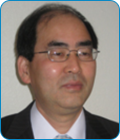 |
Prof. Young W. Kwon Distinguished Professor, Dept. of Mechanical and Aerospace Engineering, Naval Postgraduate School, USA Editor, Journal of Pressure Vessel Technology (ASME Transactions) Editor, Multiscale and Multidisciplinary Modeling, Experiments and Design (Springer Nature) Director, Center for Materials Research Failures in Perspective of Multiscale and Multiphysics Abstract Biography Presentation Material Abstract
Most of engineering materials have their hierarchical structures at different length scales. The structure in each length scale influences one another and eventually the macroscale properties of the materials. In order to understand and predict macroscale properties of materials, it is important to analyze the characteristics and bridging of different length scale structures. To this end, multiscale modeling has been developed for different materials such as composites, metals, biomaterials, etc. This presentation will focuse on a multiscale analysis model developed for various composites materials as well as biomaterials including new failure criteria based on distinctive failure mechanisms of the constituent materials such as fiber failure, matrix cracking and fiber/matrix interface debonding. The criteria use the stress and strain occurring in the fiber and matrix materials. Furthermore, many engineering structures, especially for marine applications, interact with fluid media, Then, the Fluid-Structure Interaction (FSI) becomes an important issue, and FSI can change the failure loads as well as failure locations. The presentation will address such problems with composite structures. Biography Young Kwon is Distinguished Professor of the Mechanical and Aerospace Engineering Department of the Naval Postgraduate School (NPS) in Monterey, California, USA. He also serves as Director of the Materials Research Center at NPS and was the Chair of the department. Previously, he was Professor and Chair of the Department of Mechanical Engineering and Energy Processes of Southern Illinois University Carbondale (SIUC). He received his Ph.D. degree from Rice University, and B.S. degree from Seoul National University, all in mechanical engineering. Before joining NPS, he was Assistant Professor at the University of Missouri-Rolla. His research interests are multiscale, multiphysics and multidisciplinary problems in engineering and sciences. He wrote multiple books, Finite Element Method using MATLAB which was translated into Greek, Multiscale and Multiphysics Modeling: Techniques and Applications, and Composite Structures for Fluid-Structure Interaction. He edited a book titled Multiscale Modeling and Simulation of Composite Materials and Structures. He received many awards including the Cedric K. Ferguson Medal, Menneken Awards, Excellent Research Award from American Orthopedic Society of Sports Medicines, Outstanding Instruction and Research Awards, ASME Dedicated Service Award, ASME PVPD Outstanding Service Award, ASME Board of Governors Award, ASME PVP Medal, National Dean's List, etc. He is a fellow of ASME. He serves as Technical Editor for ASME Transactional, Journal of Pressure Vessel Technology, as well as Multiscale and Multidisciplinary Modeling, Experiments and Design published by Springer Nature. He was a ASME PVP Division Chair. |
||
|
|
|||
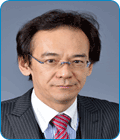 |
Prof. Nobuhiro Yoshikawa The University of Tokyo, Japan Meso-scale Fracture Modeling of Carbon Fiber Reinforced Plastic Abstract Biography Presentation Material Abstract
The safety of the Carbon Fiber Reinforce Plastic (CFRP) members have been mostly examined by the qualification and production tests so far since the Finite Element (FE) modeling of CFRP members were not so sophisticated enough as to yield reliable failure analysis result. Instead of conventional continuum-based modeling method, we have proposed meso-scale modeling, where carbon fiber and resin are exactly separated. Strength models of carbon fiber and resin are directly introduced for adequate strength prediction of CFRP members. We exemplify the merit of the proposed methodology in a problem of high pressure hydrogen container for fuel cell vehicle. The tank is made by filament winding method. Local strain enhancement in carbon fiber bundle caused by cross-over is precisely evaluated and the burst pressure of the tank is adequately predicted by means of the meso-scale finite element analysis. Biography Nobuhiro Yoshikawa is a professor at the University of Tokyo, Tokyo, Japan since 2005. He obtained his BS and MS degree in Mechanical Engineering at the University of Tokyo in 1985 and 1987, respectively and Ph.D. degree. in Mechanical Engineering at the same affiliation, the University of Tokyo in 1990. He has spent over 30 years in his research as from a research associate to a professor at Institute of Industrial Science, the University of Tokyo in Japan. He served in charge of the head of the 92nd Material Dynamics Division of JSME. His research interests include Developing methodology of structural safety and reliability analyses by means of finite element method, especially in the application for Carbon Fiber Reinforced Plastics (CFRP); (1) Developing finite element simulation system named Front_COMP for strength evaluation of CFRP members based on meso-scale model separating resin/carbon fiber bundle. (2) Developing high pressure hydrogen vessel for Fuel Cell Vehicles and hydrogen station. (3) Developing fun blade of jet engine made by CFRP. |
||
|
|
|||
 |
Prof. Gang Liu Xi’an Jiaotong University, China Stabilizing nanoprecipitates in Al-Cu alloys for creep resistance at 300°C Abstract Biography Presentation Material
Abstract
Abstract Commercial precipitation-hardened Al-Cu alloys are normally used at temperatures below its ageing temperature of ∼225°C, to avoid thermally induced precipitate coarsening and resultant softening. Making such popular Al alloys creep resistant at or above 300°C is thus challenging. Here we present a modified precipitation protocol, exploiting Sc-microalloying and a carefully designed three-step heat treatment to enhance Sc segregation at the matrix/θ-Al2Cu precipitate interfaces. The stabilized nanoprecipitates enable an order-of-magnitude reduction in creep rate at 300°C, demonstrating the room for microstructure improvement and the potential for property elevation in traditional engineering alloys through innovative processing coupled with synergetic alloying elements.
Biography Dr. Gang Liu received his Bachelor degree from Wuhan Institute of Iron & Steel (Wuhan, China) in 1996, master degree from Xi’an University of Technology (Xi’an, China) in 1999, and Ph. D. degree from Xi’an Jiaotong University (Xi’an, China) in 2002. He then worked as a post-doctor in Tsinghua University (Beijing, China) from 2003 to 2005, and as an Alexander von Humboldt Research Fellow in Leibniz Institute for Solid State Materials Research (Dresden, Germany) from 2008 to 2009. Since 2005, he has been a faculty member as an Associate Professor (2005-2008) and Full Professor (2008-now) in Xi'an Jiaotong University, China. Currently, he is the vice director of the State Key Laboratory for Mechanical Behavior of Materials. Dr. Liu, as the Cheung Kong Professor (by the Ministry of Education, China, 2016), was sponsored by the National Science Fund for Distinguished Young Scholars (NSFC, 2016) and for Excellent Young Scholars (NSFC, 2013). He received the Second-Prize State Natural Science Award in 2017 and the Second-Prize State Technological Invention Award in 2013, both by the National Office for Science & Technology Awards, China. His research interests mainly include the processing-microstructure-property correlations in metallic materials and the alloy design of advanced metallic materials with enhanced performance. He has published 180 peer-reviewed journal papers, including 1 in Nature Materials and 29 in Acta Materialia. The published papers have been cited by others more than 4300 times in SCI index. Dr. Liu co-chaired the Second International Conference of Young Researchers on Advanced Materials (IUMRS-ICYRAM 2014) and was a member of the International Board of APCFS-2016 and APCFS-2018. He now serves for the committee of the Youth Branch and the Fatigue Branch of the Chinese Materials Research Society, and for the committee of the Materials Branch of the Chinese Mechanical Engineering Society. |
||
|
|
|||
 |
Prof. Elena Pasternak University of Western Australia, Australia Topological Interlocking as a Method of Improving Structural Integrity and Resilience Abstract Biography Abstract
Ancient mortarless structures that is segmented/blocky structures without binder with segments holding together on gravity friction are known to have amazing resilience to external impacts and vibration. This can be attributed to the relative movement of segments/blocks that increases the dissipation of the vibration energy. The need for high block mass to mobilise gravity restricts the used segmented materials. This is where the principal of topological interlocking assists by providing considerable kinematic constraint preventing the block removal from the structure. This is achieved by either specially engineered block shape (e.g., osteomorphic blocks, Fig. 1 [1]) which provides interlocking without stress concentrators such as keys or connectors, or by special arrangements of simple shapes such as Platonic solids (e.g., octahedra, Fig. 2 [1]). This enables manufacturing hybrid materials and structures whose integrity is only maintained by providing peripheral constraint. These materials and structures are characterised by increased fracture resistance and energy absorption. Some topological interlocking structures also exhibit high tolerance to missing blocks. Since the segments/blocks are not directly connected to each other the described principal also allows creating hybrid materials of segments/blocks made of different not necessarily compatible materials thus increasing the dimension of the parametric space (e.g., [2]) in designing hybrid materials.
Biography Professor Elena Pasternak received BSc and MSc in Mechanics and Applied Mathematics in 1997 from Dnepropetrovsk State University, Ukraine and PhD in 2002 from the University of Western Australia. In 2002 she became a Humboldt Fellow at Technical University of Clausthal. In 2003-2006 Elena was an Australian Postdoctoral Fellow at the University of Western Australia. Currently, she is a Professor at the Department of Mechanical Engineering of the University of Western Australia. Professor Pasternak’s research interests cover different areas in fracture mechanics, rock mechanics, wave propagation and vibrations, topological interlocking, auxetics and negative stiffness. This determines a wide range of leading journals she publishes in such as fracture mechanics journals Int. J of Fracture and Engineering Fracture Mechanics, rock mechanics journals: Int. J. of Rock Mechanics and Mining Sciences and Rock Mechanic sand Rock Engineering, engineering journals: Int. J. of Engineering Science, Solids and Structures and J. of Sound and Vibrations. Professor Pasternak is President of the Australian Fracture Group. |
||
|
|
|||
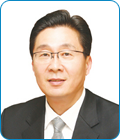 |
Prof. Dongil Kwon Seoul National University, Korea Multi-scale Assessment of Mechanical Properties and Residual Stress using Instrumented Indentation Technique (IIT) Abstract Biography Presentation Material Abstract
Evaluating the reliability of industrial structures like power plants is very important since unexpected deformation and failure can cause economic and human loss. Conventional tests for determining the mechanical properties and residual stress, the main parameters in assessing structural reliability, require specimens of specific dimensions and time-consuming procedures. Furthermore, since they are destructive tests, they cannot be applied in the field. Instrumented indentation testing (IIT) has been studied to overcome these limitations. IIT can measure load and depth continuously and determine mechanical properties and residual stress by analyzing load and depth curves. In addition, IIT can be used on macro/micro/nano scale depending on the load range and also applied to in-field structures nondestructively. Here, I introduce the basic principles published in international standards for evaluating mechanical properties and residual stress using IIT and in-field application in various industries. Using this test, we successfully estimated the mechanical properties and residual stress and its results are described in this study.
Biography Dongil Kwon received B.S. and M.S. in Mechanical Engineering at Seoul National University, Seoul, Korea in 1979 and 1981, respectively and Ph.D. in Materials Science & Engineering at Brown University, US in 1987. He has been a professor of Materials Science & Engineering at Seoul National University. His research interests include through a non-destructive method called instrumented indentation test(IIT), it is possible to quantitatively and accurately measure the mechanical properties of materials, and the residual stress remaining in materials. Based on this technology, we contribute to the international standardization and industrialization of technology. |
||
 Fig. 1 Assembled from osteomorphic blocks
Fig. 1 Assembled from osteomorphic blocks Fig. 2 Interlocking assembly of octahedra
Fig. 2 Interlocking assembly of octahedra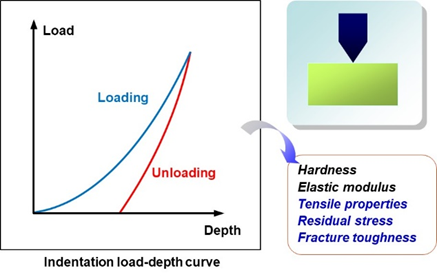 Fig. 1 Instrumented Indentation Test
Fig. 1 Instrumented Indentation Test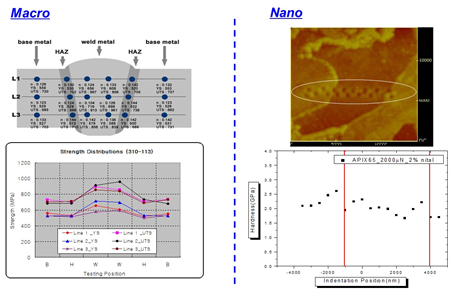 Fig. 2 Multi-scale assessment using Instrumented indentation
Fig. 2 Multi-scale assessment using Instrumented indentation